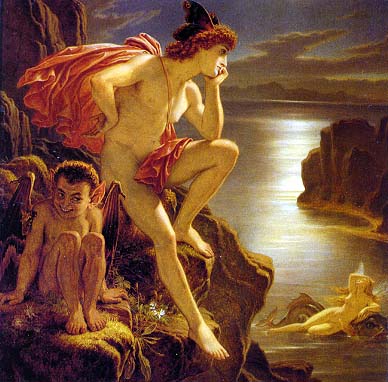
Oil on canvas, approximately 24 x 24 inches. Meisei University, Tokyo.

Oil on canvas, approximately 24 x 24 inches. Meisei University, Tokyo.
This painting inspired by A Midsummer Night's Dream was exhibited more than three decades after Paton's prize-winning The Reconciliation of Oberon and Titania (1847) and his Quarrel of Oberon and Titania (1850). Oberon and the Mermaid illustrates a scene we do not actually see in the play; just before Oberon sends Puck in Act II, Scene i, to fetch the love-in-idleness with which he will enchant the lovers he asks Puck if he remembers a particular night when
once I sat upon a promontory
And heard a mermaid, on a dolphin's back,
Uttering such dulcet and harmonious breath
That the rude sea grew civil at her song,
And certain stars shot madly from their spheres
To hear the sea-maid's music.
In the painting Paton depicts the memory of that night.
The impish Puck with batwings is reminiscent of the earlier paintings on A Midsummer Night's Dream, but the scantily clan Oberon reveals a new element in Paton's work. In discussing the semi-clad figures of Oberon and Titania in The Quarrel and The Reconciliation, Alison Smith suggests in The Victorian Nude that by "the 1850s, painters such as Joseph Noel Paton and Robert Huskisson had arrived at a softened fairy type, tempering any suggestion of eroticism by a delicate treatment, and enhancing their creations with the addition of gauze wings, flowing hair and wispy robes." Paton's contemporary the critic of the Spectator approved of Paton's style, remarking that his "sense of the voluptuous . . . carries him to the verge of what modern 'decorum' will tolerate, never beyond it" (Smith 92). No such sense of decorum, however, governs Paton's rendering of the nearly naked fairy in Oberon and the Mermaid. Victorian attitudes toward the male body in art had changed significantly in the 33 years between Paton's earlier paintings and this one done in 1883. Smith traces these changes in a section of The Victorian Nude, "The male nude" (pp. 135-42), beginning with the exhibition of Frederick Walker's Bathers (1865-67), a picture showing a number of young men and boys disrobing on the bank and swimming naked.
In the 1860's attitudes toward the male nude began to change when painters such as Watts, Moore, Leighton, Whistler, Poynter and Burne-Jones "all studied from the Elgin Marbles as part of the search for ideal form" (139). For a number of reasons explored by Smith, paintings with male nudes were not treated kindly by the critics, and painters were thus discouraged from depicting men and turned to the traditional female nude. Paton seems also to have been influenced in Oberon and the Mermaid, as were his colleagues, by a fleeting interest in classical ideas of male nudity.